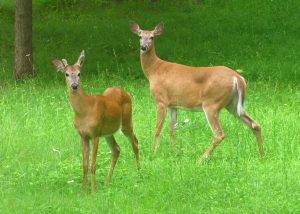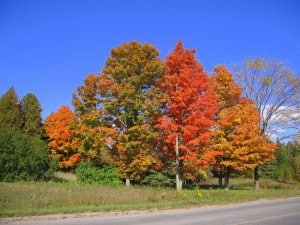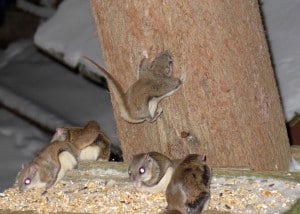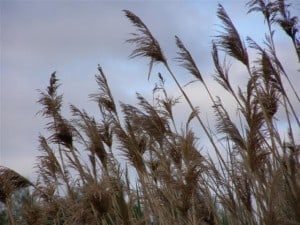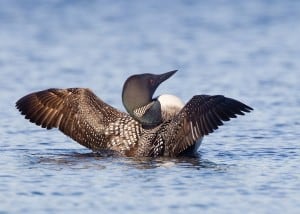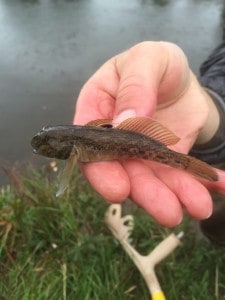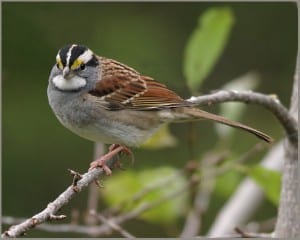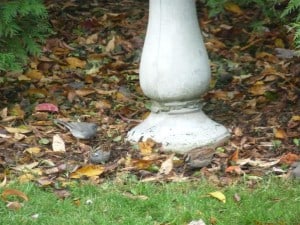Shifting dates, species declines, and surprising newcomers tell us climate change has arrived
For years we used to drive up to Algonquin Park in early summer to take our daughters to camp. One of the highlights of these trips was seeing moose along the side of Highway 60. Getting closeup looks and photographs of these huge and graceful animals was always such a thrill. Now, however, we rarely see them. Moose populations in Ontario have fallen by 20 percent – in some areas, 60 percent – in just the last decade. One of the main causes is climate change. These Canadian icons are poorly adapted to warmer temperatures. They are also dying from brainworm disease, which is arriving courtesy of the northward march of white-tailed deer. Deer are thriving as the climate warns.
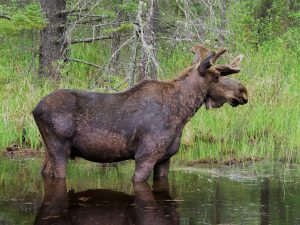
Ontario moose are struggling with the warmer temperatures ushered in by climate change. Populations are down by 20 to 60 percent. (Randy Therrien)
Slowly but steadily, nature in Central Ontario and the Kawarthas is changing. New species are arriving, the dates of key events are shifting, and extreme weather events are becoming more common. For many years now, local naturalists and biologists have been noticing and documenting these changes. What the changes all have in common is a link to a warming climate.
A new timetable
Numerous events are now happening, on average, earlier in the spring, while others are occurring later in the fall.
· In many parts of their range, bird species are arriving back earlier on their breeding grounds. These include common species like Canada geese, red-winged blackbirds, and tree swallows. The average egg-laying date for tree swallows is up to nine days earlier across North America.
· According to an OMNR study from 2012, the peak calling period of early breeding frogs such as spring peepers is now 10-20 days earlier than in 1995.
· Over the past decade or so, local wildflowers such as trilliums have often reached peak bloom in late April or early May, instead of the long-term average date of mid-May.
· Earlier plant blooming also means pollen is being released into the air earlier. With more carbon dioxide (C02) in the air, plants are able to grow bigger and produce more pollen. The pollen season is also lasting longer. Even in downtown Toronto, pollen levels are far above those recorded in the early 2000s. Data from the United States Environmental Protection Agency shows an especially big jump in the ragweed pollen season. In Winnipeg, for example, the plant’s growing season increased by 25 days between 1995 and 2015. If you are a hayfever sufferer like me, this is bad news.
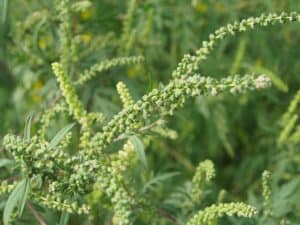
Studies are showing a big increase in the length of the ragweed pollen season. It’s bad news for hayfever sufferers. (Drew Monkman)
· On average, peak colour change in the fall leaves is happening later. Last year, for example, the best sugar maple colour was in mid-October instead of late September or early October.
· The long-term average date for freeze-up of the Kawartha Lakes is mid-December, while the ice is usually out by about April 20. Since the early 2000s, however, the lakes have often been ice-free by early April, while freeze-up hasn’t happened until January. Later freeze-up means that waterfowl are lingering on local lakes until early winter. This trend can be seen in Peterborough Christmas Bird Count records, which date back to 1952.
Plant and animal populations
· “Southern” birds are expanding their breeding range northwards into Central Ontario. These include red-bellied woodpeckers, which many people now see at their feeders.
· A study based on 22 years of data from Project FeederWatch has shown that as minimum winter temperatures have increased, birds that used to spend the winter solely in the south are now wintering further north.
· Virginia opossums and white-footed mice, both of which are southern species, have now extended their range into the Kawarthas. According to Trent University researcher, Dr. Jeff Bowman, bobcats – another southern species – are also expanding into Ontario. At the same time, the lynx’s range is contracting northwards.
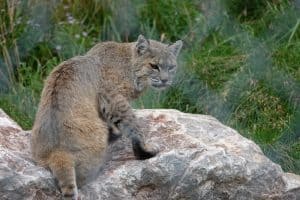
According to Trent University researcher, Dr. Jeff Bowman, bobcats are expanding their range northward into Ontario and are expected to become more common. (Drew Monkman)
· Research done by Bowman and his colleagues has also showed that during a series of warm winters between 1995 and 2003, the southern flying squirrel rapidly expanded its northern range limit. Their study demonstrated that these southern species are mating with their northern counterpart, the northern flying squirrel. This has resulted in a hybrid zone right here in the Kawarthas. The researchers believe that the range expansion and interbreeding is a possible effect of climate change.
· Southern butterfly species are also moving north into the Kawarthas. The most noticeable and common of these is the giant swallowtail, Canada’s biggest butterfly. Until recently, this species’ Canadian range was restricted to southwestern Ontario.
· Although the past few summers have seen greatly increased monarch butterfly numbers in the Kawarthas, the long-term prospects for this iconic insect are poor. Climate change-related droughts and abnormal weather patterns along the Canada to Mexico migration route are impacting numbers, as are winter storms on the Mexican wintering grounds. Warming in Mexico is also expected to disrupt the monarch’s period of reproductive diapause (suspension). If diapause ends too early, reproductive success will suffer.
· Insects such as mosquitoes and ticks are thriving in our warmer climate, with some new species spreading northward. In the past, their range was restricted by colder winter temperatures. The greater number of frost-free days is also allowing for a longer reproduction season. The black-legged tick, which carries the Lyme disease bacteria, is now well-established in the Kawarthas. Hundreds of ticks are submitted annually to Peterborough Public Health from all over our region. In the 1990s, this species was found in only one region of the province.
· We are seeing a marked increase in the abundance of non-native, invasive plant species. These include common reed (Phragmites), dog-strangling vine, and garlic mustard. Non-native invasives are more adaptable to a warming world than most native plants. They also have mostly negative impacts on our wildlife.
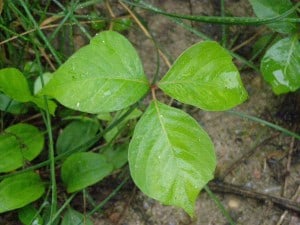
Poison Ivy – always a longer stem on middle leaflet; leaflets often asymmetrical; shiny; usually droop down a little – Drew Monkman
· Poison ivy is increasing both in abundance and in size. Its growth has been turbocharged by warmer temperatures and rising levels of carbon dioxide. The plants are also producing a more potent form of urushiol, the oily sap that causes the rash.
Concern for the future
By 2030, it’s expected that Peterborough will be about 2 C warmer in each season. We can also expect a huge increase in the number of days above 30 C. By 2060, temperatures are projected to be 5 C warmer. The climate of the Kawarthas will be like southern Pennsylvania today. What will this mean for our flora and fauna?
· A number of iconic birds may no longer be able to breed here, their ecoregion (i.e., habitat requirements) having moved further north. The call of the common loon is likely to disappear from the Kawartha Lakes.
· The health of our forests will suffer as a result of higher temperatures, drought, windstorms, invasive plants, insect pests, and fungal infections. Species such as white pine, sugar maple, and white spruce may disappear from the Kawarthas entirely as their climate zone will have moved north.
· As water temperatures increase, our lakes and wetlands will also be impacted. Although warm-water fish like large-mouthed bass should be able to cope, cool and cold-water fish like walleye and trout will struggle to survive here. The conditions may allow non-native fish like round goby to thrive and out-compete native species for food. There will likely be an increase in the types and abundance of other invasive species such as zebra mussels and Eurasian water-milfoil.
The changes we are seeing in nature in the Kawarthas represent a “canary in the coal mine” warning that climate change is happening now. But, like the proverbial frog in water that is slowly brought to a boil, we seem unable or unwilling to react to this sinister and deadly threat to the future of all life on the planet. The climate crisis should be top-of-mind when we cast our votes in October.
What to watch for this week
Southbound white-throated sparrows and dark-eyed juncos should be arriving in local backyards in the coming days. They are easy to attract by spreading millet or finch mix on the ground, preferably close to your feeder. The sparrows will linger for several weeks, before departing. Juncos sometimes stay all winter.
Climate Crisis News
Be sure to drop by the climate-crisis booth at the Purple Onion Festival at Millennium Park on Sunday, Sept. 22. There will be information on how to reduce your personal carbon footprint as well as petitions to be signed to urge city council to declare a climate emergency as soon as possible. Other climate events scheduled for the coming weeks include the Global Climate Action Day (Sept. 27 at Millennium Park from 12:00-3:00 pm) and 100 Debates on the Environment (Oct. 3 at the Students Centre at Trent University from 7:00-9:00 pm.) The local candidates in the federal election will be taking part. This event had previously been scheduled to take place at Trinity United Church. 100 Debates for the Environment is a non-partisan, nationwide effort to highlight environmental issues in the election. More information can be found at 100debates.ca.
